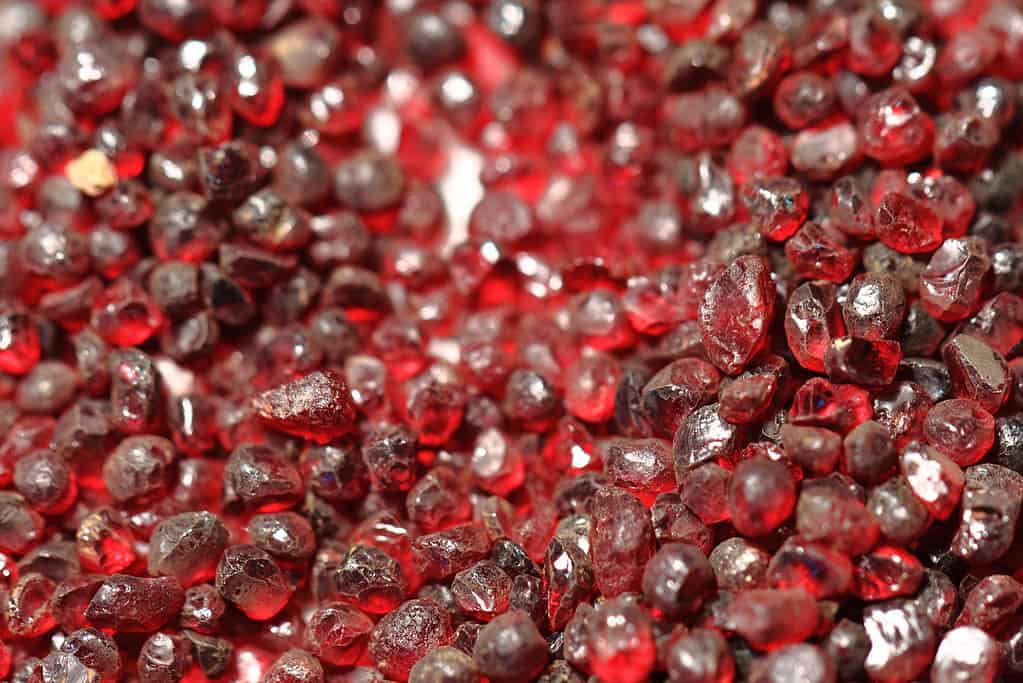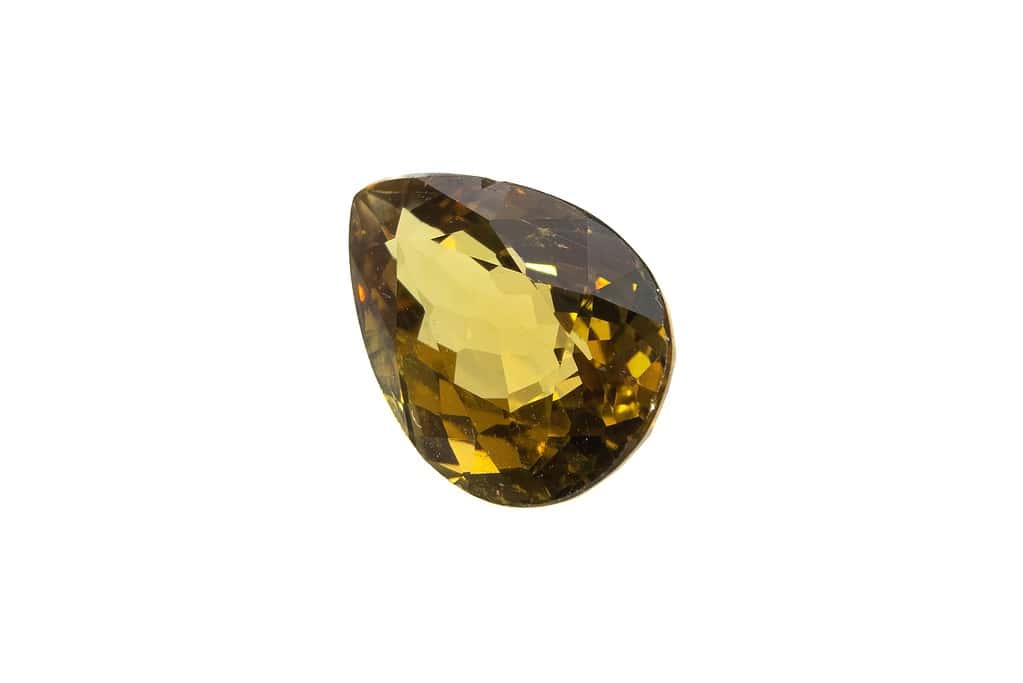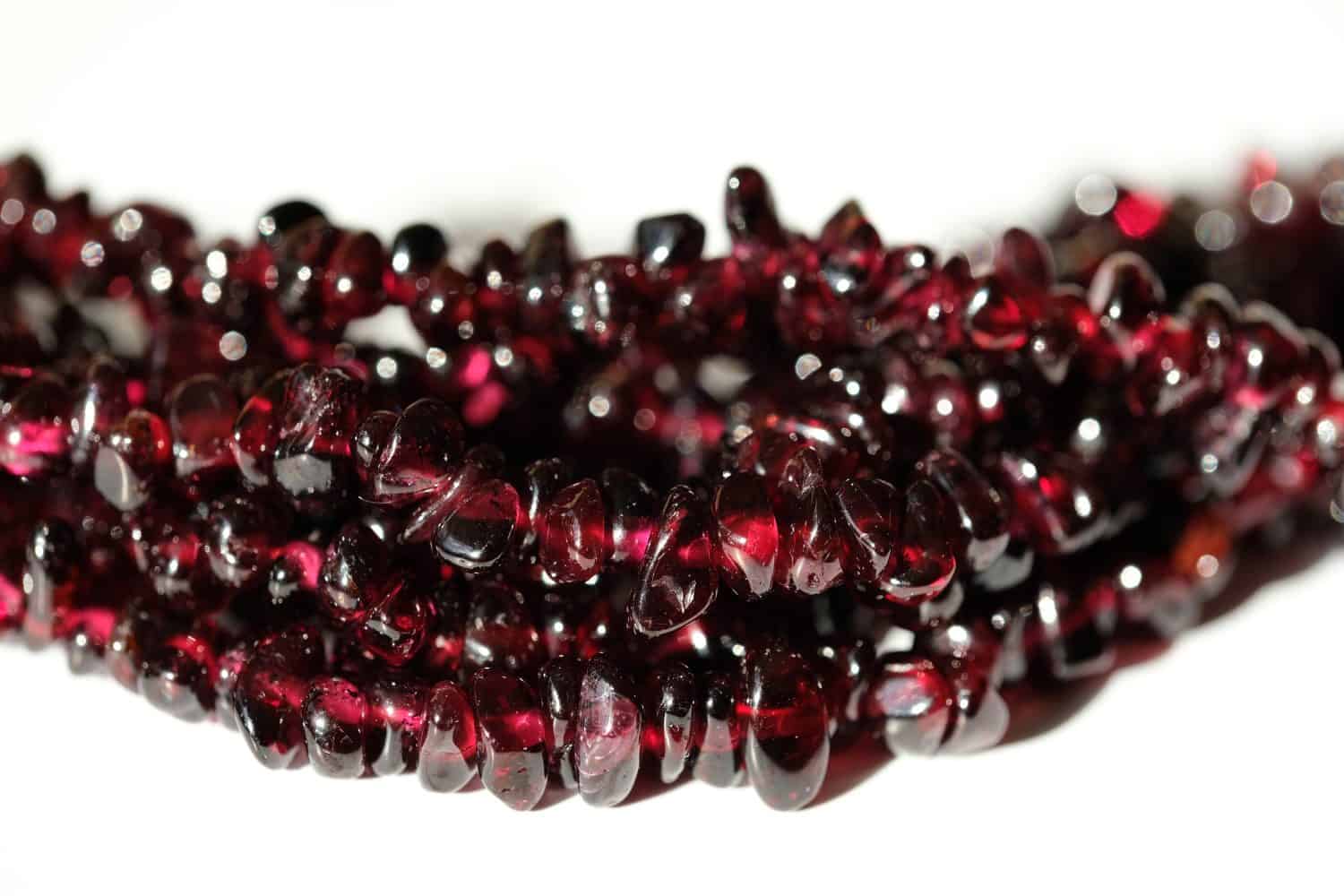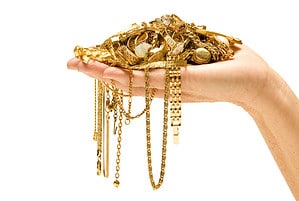Garnets are not considered precious stones, despite their sometimes rather high value. Instead, they are more often classed as semiprecious stones. However, their rich history and the garnet’s symbolism show them to be much more valuable than you’d assume, at least in the past.
This is one of the oldest stones used in the world and has been worn by thousands of people as a form of protection and to ensure their safety.
What Is Garnet?

When naturally mined, garnets look a lot like pomegranate seeds, which is where their name may have come from.
©jonnysek/iStock via Getty Images
Garnet is a silicate mineral that’s found all over the world. Though it comes in a variety of colors, deep red garnets are the most common color. They’re usually a more blood-red color than rubies, but their shading often overlaps. They are also the birthstone for January.
In their natural form, garnets contain many rounded shapes. They are similar to pomegranate seeds in shape. It’s thought that this is how they got their name. It comes from the Latin word granatus, which means “seed” or “grain”, and is thought to reference the seeds of pomegranate fruits.
Garnets are found all over the world. Mines are most commonly in Australia, the U.S., South Africa, India, Canada, Europe, and Madagascar.
Unfortunately, most garnets harvested are of rather poor quality. Only a tiny percent work as gemstones.
Garnet Colors
Garnets come in all sorts of colors, technically. However, for every color they come in, they change their name. They are all classed as garnets because they share a similar pattern of crystal.
The different colors come from different minerals. Calcium, iron, aluminum, and magnesium all play parts.
- Demantoid: This is a very rare version of garnet that looks blue-green or pure green.
- Almandite: This is the most common of garnets and is red with a hint of violet.
- Tsavorite: This is a green or blue-green stone that is very rare.
- Spessartite: This is a more orange stone, though it can be brownish-red similar to bricks.
- Lotus: Lotus is a rather new type of garnet first found in 2015 that is a mix of several other garnets like pyrope, spessartine, and almandine.
- Rhodolite: This is a fairly rare version of garnet and is usually purplish-red or rose-red.
- Pyrope: Pyrope is a deep red stone, usually with a hint of brown.
- Malaia: Malaia is usually made up of hues surrounding red, like pink, orange, or a mix of the two.
- Hessonite: Hessonite is brownish-red, similar to cinnamon.
Of these stones, you might expect that the red ones are the most valuable. While rhodolite is uncommon and pretty prized because of that, it’s actually not the most expensive.
In fact, it’s the blue-green tsavorite and demantoid with green tones that are the rarest.
The History of Garnet

Garnets have been used throughout history for many different purposes and in many different ways.
©MelaMari/Shutterstock.com
Garnet has been around for a long time, likely over a millennia. Scientists believe it’s one of the oldest gemstones in human history. That’s not to say it was one of the first stones ever made by the earth, but one of the first ones that people mined and used.
This stone has been found as far back as Ancient Egypt. It was used in necklaces, talismans, tombs, and buried with mummies.
Ancient Romans and Greeks also used garnets. They were used for jewelry such as broaches and necklaces as well as signet rings for sealing important letters and documents.
Though it’s often hard to see how far back a stone was used because many stones were originally clumped together because of color, there is still evidence of garnets used in the items described above. This makes it easy to know exactly which stone was used and how far back its use dates.
When it comes to written history, though, it’s harder. For a long time, any red stone was called “carbuncles” which referred to any blood-red stone. The word comes from the Latin word carbunculus which means “small, hot coal” and may refer to the shiny, fiery coloring that many of these stones had.
However, many carbuncles end up being red garnets, usually almandines, but not all of them. Some were rubies and other red stones. Because of this, many of these red stones share similar symbolism and uses.
Garnet Symbolism and Uses

Some garnets come in colors other than red but it was the red ones that had most of the symbolism and focus throughout history.
©galka3250/Shutterstock.com
Garnets are said to symbolize a wide range of things. When it comes to modern symbolism, this stone represents protection, friendship, commitment, love, and trust. Supposedly, garnets also protect those wearing the stone when they’re traveling, similar to rubies.
Garnets also serve many purposes in modern society, including acting as thin films, and possibly as a part of lithium batteries.
While garnet does work as a gemstone, it needs a bit of care and protection. They rank about a 7 on Moh’s Hardness Scale. This means that they hold up against most scratches, but a hard blow or wearing it when you’re using your hands a lot may end up scratching and damaging the stone.
Like other red stones, garnets offered protection. This theory is spread throughout the world. Celtic and Saxon kings wore jewelry containing garnets for this reason. Native Americans carried around the stones to protect against poison and most injuries. Even King Solomon supposedly wore garnets when he fought. Both Muslims and Christians wore the stone during the Crusades to protect themselves.
These stones were also worn by many royalty, including Queen Victoria, Mary Queen of Scots, and many Russian Czarinas. It was a way to add a layer of protection and show off their wealth.
Thank you for reading! Have some feedback for us? Contact the AZ Animals editorial team.








